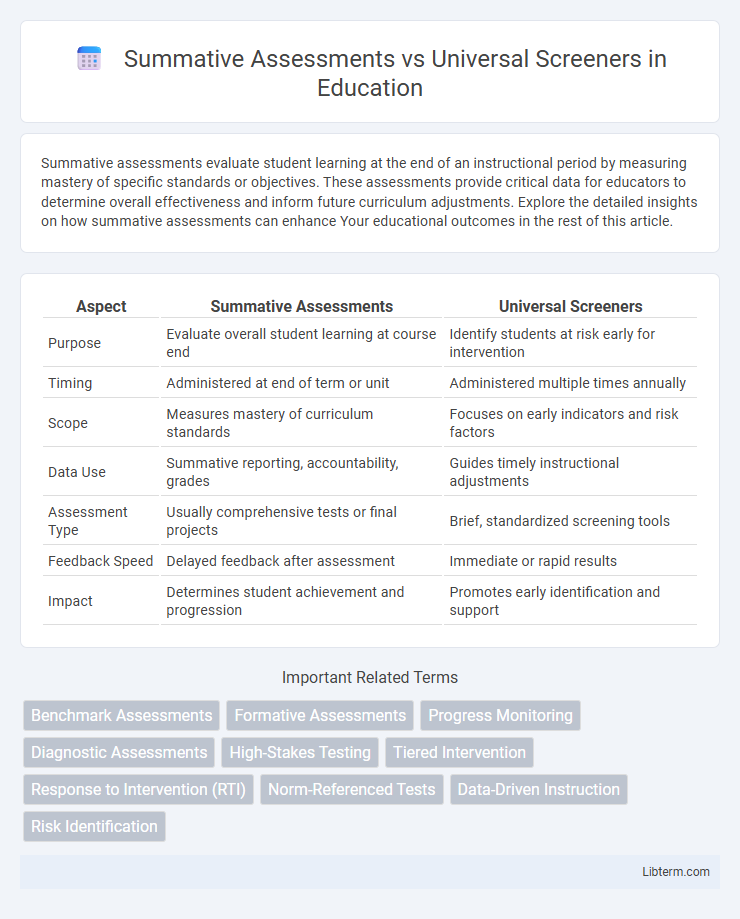Summative assessments evaluate student learning at the end of an instructional period by measuring mastery of specific standards or objectives. These assessments provide critical data for educators to determine overall effectiveness and inform future curriculum adjustments. Explore the detailed insights on how summative assessments can enhance Your educational outcomes in the rest of this article.
Table of Comparison
| Aspect | Summative Assessments | Universal Screeners |
|---|---|---|
| Purpose | Evaluate overall student learning at course end | Identify students at risk early for intervention |
| Timing | Administered at end of term or unit | Administered multiple times annually |
| Scope | Measures mastery of curriculum standards | Focuses on early indicators and risk factors |
| Data Use | Summative reporting, accountability, grades | Guides timely instructional adjustments |
| Assessment Type | Usually comprehensive tests or final projects | Brief, standardized screening tools |
| Feedback Speed | Delayed feedback after assessment | Immediate or rapid results |
| Impact | Determines student achievement and progression | Promotes early identification and support |
Introduction to Summative Assessments and Universal Screeners
Summative assessments evaluate student learning at the end of an instructional period, providing data on overall achievement and mastery of standards. Universal screeners are brief, formative tools used at the beginning or throughout the school year to quickly identify students who may need additional support or interventions. Both serve critical roles in educational decision-making by guiding instruction and resource allocation based on comprehensive and early performance data.
Defining Summative Assessments
Summative assessments are evaluations conducted at the end of an instructional period to measure student learning against predetermined standards or benchmarks. These assessments provide comprehensive data on student achievement, often used for accountability and grading purposes. Unlike universal screeners, which identify potential learning difficulties early, summative assessments focus on overall mastery after instruction.
Understanding Universal Screeners
Universal screeners are brief, standardized assessments designed to identify students at risk for learning difficulties across broad academic areas such as reading and math early in the school year. Unlike summative assessments, which evaluate student learning at the end of an instructional period, universal screeners provide timely data to inform targeted interventions and monitor progress. These tools enhance early detection of learning gaps, enabling educators to implement support strategies before difficulties become more entrenched.
Key Purposes of Summative Assessments
Summative assessments primarily evaluate student learning, skill acquisition, and academic achievement at the end of an instructional period, providing data for final grading and accountability. They offer comprehensive insights into curriculum effectiveness and guide decisions on student promotion or interventions. Unlike universal screeners, which identify students at risk early in the learning process, summative assessments measure cumulative knowledge mastery.
Primary Goals of Universal Screening
Universal screeners primarily aim to identify students at risk of learning difficulties early, enabling timely intervention to prevent academic failure. These assessments provide quick, reliable data on students' overall performance in key areas such as reading and math, allowing educators to target instruction effectively. Unlike summative assessments, which evaluate cumulative knowledge at the end of an instructional period, universal screeners focus on early detection and ongoing monitoring to support differentiated teaching strategies.
Differences in Data Collection and Analysis
Summative assessments collect data at the end of an instructional period, providing a comprehensive evaluation of student learning outcomes through standardized tests or final projects. Universal screeners gather data frequently and early in the educational process, identifying students' strengths and weaknesses to inform immediate intervention strategies. Analysis of summative assessment data focuses on overall achievement and long-term trends, while universal screener data emphasizes real-time progress monitoring and early identification of learning difficulties.
Advantages of Summative Assessments
Summative assessments provide comprehensive evaluations of student learning by measuring mastery of curriculum standards at the end of an instructional period, enabling educators to make data-driven decisions for curriculum adjustments and student placement. These assessments offer reliable benchmarks for comparing performance across different populations and timeframes, supporting accountability and informing policy decisions. The depth and scope of summative data facilitate targeted interventions and improve overall educational outcomes by identifying knowledge gaps and areas for growth.
Benefits of Universal Screeners
Universal screeners provide early identification of students' learning needs, enabling timely interventions that improve academic outcomes. These tools offer quick, efficient, and broad data collection across grade levels, facilitating targeted instruction and resource allocation. By capturing a comprehensive snapshot of student performance, universal screeners help educators prevent learning gaps before they widen.
When to Use Each Assessment Type
Summative assessments are best used at the end of instructional periods to evaluate overall student learning and mastery of specific standards, providing data for accountability and curriculum planning. Universal screeners are designed for early identification of students at risk, administered frequently throughout the school year to guide immediate instructional interventions and prevent learning gaps. Selecting the appropriate assessment depends on whether the goal is to measure cumulative achievement or to monitor ongoing progress for timely support.
Conclusion: Summative Assessments vs Universal Screeners
Summative assessments provide comprehensive insights into student learning at the end of instructional periods, highlighting overall achievement and guiding long-term educational decisions. Universal screeners efficiently identify students at risk early in the academic year by evaluating key skills across a wide population, enabling timely interventions. Combining data from both summative assessments and universal screeners optimizes educational outcomes through precise monitoring and targeted support.
Summative Assessments Infographic

 libterm.com
libterm.com